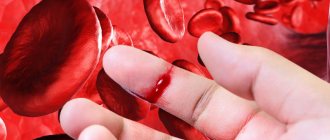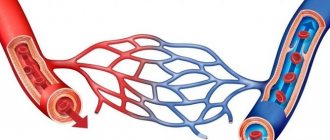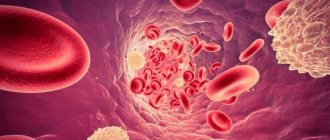| Fredrickson classification of hyperlipidemias | ||||
| Hyperlipoproteinemia | Synonyms | Etiology | Detectable violation | Treatment |
| Type I | Primary hyperlipoproteinemia , | Reduced lipoprotein lipase (LPL) or disorder of the LPL activator - apoC2 | Elevated chylomicrons | Diet |
| Type IIa | Polygenic hypercholesterolemia , | LDL receptor deficiency | Elevated LDL | Statins, Nicotinic acid |
| Type IIb | Combined hyperlipidemia | Decreased LDL receptor and increased apoB | Elevated LDL, VLDL and triglycerides | Statins, Nicotinic acid, Gemfibrozil |
| Type III | Hereditary dys-beta lipoproteinemia | ApoE defect (apoE 2/2 homozygotes) | Increased DILI | Mainly: Gemfibrozil |
| Type IV | Endogenous hyperlipemia | Increased formation of VLDL and their delayed breakdown | Elevated VLDL | Mainly: Nicotinic acid |
| Type V | Hereditary hypertriglyceridemia | Increased formation of VLDL and decreased lipoprotein lipase | Elevated VLDL and chylomicrons | Nicotinic acid, Gemfibrozil |
Hyperlipoproteinemia type I
A rare type of hyperlipidemia that develops due to LPL deficiency or a defect in the LPL activator protein, apoC2. Manifests itself in increased levels of chylomicrons, a class of lipoproteins that transport lipids from the intestines to the liver. The frequency of occurrence in the general population is 0.1%.
Hyperlipoproteinemia type II
The most common hyperlipidemia.
Characterized by an increase in LDL cholesterol. Divided into types IIa and IIb depending on the absence or presence of high triglycerides. Type IIa
This hyperlipidemia may be sporadic (as a result of poor diet), polygenic, or hereditary.
Hereditary hyperlipoproteinemia type IIa develops as a result of a mutation in the LDL receptor gene (0.2% of the population) or the apoB gene (0.2% of the population). The familial or hereditary form is manifested by xanthomas and early development of cardiovascular diseases. Type IIb
This subtype of hyperlipidemia is accompanied by an increased concentration of triglycerides in the blood as part of VLDL. High levels of VLDL occur due to increased formation of the main component of VLDL - triglycerides, as well as acetyl-coenzyme A and apoB-100. A more rare cause of this disorder may be slow clearance (removal) of LDL. The frequency of occurrence of this type in the population is 10%. This subtype also includes hereditary combined hyperlipoproteinemia and secondary combined hyperlipoproteinemia (usually in metabolic syndrome). Treatment of this hyperlipidemia includes dietary changes as a major component of therapy. Many patients require statins to reduce the risk of cardiovascular disease. In cases of severe elevation of triglycerides, fibrates are often prescribed. The combination of statins and fibrates is highly effective, but has side effects such as the risk of myopathy, and should be under constant medical supervision. Other medications (nicotinic acid, etc.) and vegetable fats (ω3-fatty acids) are also used.
Hyperlipoproteinemia type III
This form of hyperlipidemia is manifested by an increase in chylomicrons and DILI, therefore it is also called dys-beta-lipoproteinenia. The most common cause is homozygosity for one of the apoE isoforms, E2/E2, which is characterized by impaired binding to the LDL receptor. Occurrence in the general population is 0.02%.
Hyperlipoproteinemia type IV
This subtype of hyperlipidemia is characterized by elevated triglyceride concentrations and is therefore also called hypertriglyceridemia. The frequency of occurrence in the general population is 1%.
Hyperlipoproteinemia type V
This type of hyperlipidemia is in many ways similar to type I, but is manifested not only by high chylomicrons, but also by VLDL
Publications in the media
Hyperlipidemia - increased levels of lipids in the blood (>8 g/l). The predominant gender is male.
Etiology • Primary (see below) • Secondary •• Obesity •• Diabetes •• Pregnancy •• Chronic renal failure •• Hypothyroidism •• Nephrotic syndrome •• Acromegaly •• SLE •• Dysgammaglobulinemia •• Glycogenosis type I •• Lipodystrophy •• Taking certain Medicines (oral contraceptives, b-blockers, diuretics, GCs).
Pathomorphology • Atherosclerosis • Pancreatitis • Infiltration of internal organs, bone marrow and skin with foam cells - macrophages containing large amounts of lipids (chylomicronemic syndrome).
Lipid metabolism. Lipids supplied with food are transported into adipose tissue as part of VLDL and chylomicrons. Lipoprotein lipase hydrolyzes these lipids to fatty acids. Free fatty acids penetrate adipocytes and are stored in fat droplets in the form of triglycerides (TG). Stored TGs are hydrolyzed by hormone-sensitive lipase activated by cAMP. Next, free fatty acids enter the lumen of the capillaries, where they non-covalently bind to albumin and are transported to the liver.
Types of hyperlipoproteinemia • Acquired (sporadic) develops as a consequence of an underlying disease (for example, hypothyroidism) • Familial. A group of diseases characterized by changes in the concentration of b-lipoproteins, pre-b-lipoproteins and corresponding lipids (hyperlipidemias are also included as part of the general classification) •• IA (*238600, lipoprotein lipase deficiency, 8p22, r, [EC 3.1.1.34]) . There are many chylomicrons and TG in the blood on a regular diet (disappear on a low-fat diet), low levels of a- and b-lipoproteins on a regular diet (increases on a low-fat diet), decreased post-heparin lipolytic activity of plasma; accompanied by attacks of abdominal pain, hepatosplenomegaly, ulcerating xanthomas. Synonyms: familial fat-mediated (lipid-induced) lipemia, familial (hyper)chylomicronemia, familial hyperglyceridemia, idiopathic familial hyperlipemia, Buerger-Grütz syndrome •• IB (*207750, 19q13.2, apolipoprotein C deficiency II, r, see also Apolipoprotein defects) : pancreatitis and hypertriglyceridemia •• IC (familial chylomicronemia, *118830, circulating lipoprotein lipase inhibitor, Â): abdominal pain, splenomegaly, pancreatitis; low post-heparin lipolytic activity with high activity of lipoprotein lipase in adipose tissue, normal or increased content of apolipoprotein C-II •• II (144400, Â) is characterized by an increase in the blood plasma content of b-lipoproteins, cholesterol, phospholipids with normal TG content (type IIA) ; atheromatosis, type IIB - with hypertriglyceridemia. Synonyms: familial hypercholesterolemia, familial hypercholesterolemic xanthomatosis •• IIA (*143890, LDL receptor gene LDLR, FHC, 19p13.2–p13.1, Â): xanthomas, xanthelasmas, coronary artery disease, hypercholesterolemia •• Type II with deafness (144300, Â ) •• III. Inherited (*107741, apolipoprotein E defect, 19q13.2, r, pseudodominance, see also Apolipoprotein defects), with increased plasma levels of low-density lipoproteins (LDL), b-lipoproteins, pre-b-lipoproteins, cholesterol, phospholipids and TG; hypertriglyceridemia occurs with a diet high in carbohydrates (characterized by impaired glucose tolerance); ulcerated xanthomas, atheromatosis, and severe ischemic heart disease are common. Synonyms: familial hyperbetalipoproteinemia and hyperprebetalipoproteinemia, familial hypercholesterolemia with (hyper)lipemia, carbohydrate-mediated (hyper)lipemia, dysbetalipoproteinemia •• IV (*144600, Â). In the blood plasma with a normal diet, the concentration of VLDL, pre-b-lipoproteins and TG is high; the content of b-lipoproteins, cholesterol and phospholipids is normal; triglyceridemia is observed with a high carbohydrate content in the diet; Impaired glucose tolerance and ischemic heart disease are possible. Synonyms: familial hyperprebetalipoproteinemia, familial hypertriglyceridemia •• V (*144650, Â). Combined lipemia caused by fats and carbohydrates; in the blood plasma with a normal diet, the concentration of chylomicrons, VLDL, pre-b-lipoproteins and TG is increased; the cholesterol content is slightly increased, the level of b-lipoproteins is normal; may be accompanied by attacks of abdominal pain, hepatosplenomegaly, the development of atherosclerosis, and impaired glucose tolerance. Synonyms: familial chylomicronemia with hyperprebetalipoproteinemia, combined (familial) fat-mediated hyperlipemia, mixed hyperlipemia; also hyperlipidemia type V (238400, r), sometimes observed in patients with apolipoprotein C-II deficiency (see also Apolipoprotein Defects) •• VI (238500, r) Moderate diabetes, episodes of abdominal pain, xanthomas are possible; hyperchylomicronemia, hyperprebetalipoproteinemia, mixed hyperlipemia (a and b-lipoproteins are normal or below normal). Synonyms: familial hyperchylomicronemia with hyperprebetalipoproteinemia, combined (familial) fat-mediated hyperlipemia.
Laboratory tests • Examination of fasting blood plasma lipids • Milky serum • Synovial fluid for non-inflammatory joint damage (concentration of leukocytes <2,000 in 1 μl, neutrophils <25%) • Serum uric acid - concentration may increase.
Notes • In pancreatitis caused by hypertriglyceridemia, the concentration of amylase in the serum or urine may be normal due to the interaction of amylase with plasma lipids during the analysis • With severe hypertriglyceridemia, pseudohyponatremia may develop.
X-ray examination • X-ray of joints •• osteoporosis •• cyst-like reconstruction of bone tissue.
Special studies • Determination of the concentration of cholesterol in HDL - an inverse relationship with the amount of TG • Determination of the content of apolipoprotein B (helps to identify a group of patients with moderate hypertriglyceridemia and a high risk of coronary artery disease) • CT scan of the pancreas for the diagnosis of pancreatitis • Doppler study and angiography for the diagnosis of atherosclerosis.
Models of atherosclerosis • Modeling of atherosclerosis in animals (mainly rabbits) was previously carried out by feeding significant amounts of lipids. Currently, the pathogenesis of the disease is being studied in mice with modified genes •• ApoE defect: significant damage to the vascular wall develops, but the composition of lipoproteins in the blood is different from that in humans •• Defect in LDL receptors (LDLR gene) and the absence of apolipoprotein B-48 (APOB gene , distorted processing: LDL cholesterol content is significantly increased, in homozygotes much higher than in heterozygotes •• Defect in LDL receptors (LDLR gene) and overexpression of apolipoprotein B-48 (APOB gene): LDL cholesterol and triglycerides are significantly increased.
Treatment and prevention - see Atherosclerosis.
The course and prognosis are good for secondary hyperlipidemia, if the underlying cause is eliminated. For primary hyperlipidemia, lifelong therapy is required.
Concomitant pathology. Hypercholesterolemia.
Abbreviations • TG - triglycerides
ICD-10 • E78 Disorders of lipoprotein metabolism and other lipidemias
APPLICATIONS
Lipase deficiency. Liver lipase (EC 3.1.1.3 lipase), lipoprotein lipase (EC 3.1.1.34) and lecithin-cholesterol acyltransferase (EC 2.3.1.43) are essential for the regulation of plasma lipids. Lipase and lipoprotein lipase function on the surface of the endothelium of blood vessels (both liver and extrahepatic vessels). Deficiency of these enzymes is always associated with dislipoproteinemia; deficiency of lipoprotein lipase is the cause of hyperlipoproteinemia type IA.
Lipoprotein lipase (246650, EC 3.1.1.34, LPL gene, about 40 defective alleles, 8p22, r) is an enzyme responsible for eliminating nutritional hyperlipemia in plasma and milk by hydrolyzing fats • Synonyms •• Lightening factor •• Lightening factor lipase •• Diglyceride lipase •• Diacylglycerol lipase • Reaction: triacylglycerol + H2O = diacylglycerol + fatty acid anion; also hydrolyzes triacylglycerols of chylomicrons and LPN, diacylglycerol • Carriage of the defective gene is estimated in the general population at 0.05%. At the same time, the content of triglycerides in plasma is increased and the content of HDL cholesterol is decreased. Carriers (especially women) are predisposed to the development of coronary artery disease • Clinical picture: pancreatitis, abdominal pain, nausea and vomiting, splenomegaly, xanthomas and jaundice of the skin, corneal lipemia, hyperlipidemia, hyperchylomicronemia, hypercholesterolemia.
Liver lipase (*151670, triacylglycerol lipase [lipase, triglyceride lipase, tributyrase], EC 3.1.1.3, 15q15–q22, LIPC gene, Â). deficiency is characterized by an increase in the content of triglycerides in lipoproteins, ischemic heart disease, and xanthomas.
Pancreatic lipase (*246600, EC 3.1.1.3, 10q26.1, PNLIP gene, r) hydrolyzes triglycerides in the intestine. An inhibitor—bile salts, pancreatic colipase (*120105, 6pter–p21.1, CLPS gene) prevents this effect. deficiency is clinically manifested by malabsorption of long-chain fatty acids.
Lysosomal acid lipase (*278000; cholesteryl ester acid hydrolase, hr. 10, LIPA gene, r). Mutations of the LAL gene lead to the development of Wolman's disease (cholesterol ester storage disease) or its later and milder variant. Clinically: vomiting, diarrhea, steatorrhea, bloated abdomen, hepatosplenomegaly, liver fibrosis, esophageal varices, retarded growth, development, malabsorption. Laboratory findings: foam cells and xanthomatosis of internal organs, hypercholesterolemia, possible hyperlipidemia.
ICD-10 • E78 Disorders of lipoprotein metabolism and other lipidemias. Notes • Insulin stimulates lipoprotein lipase synthesis, fat deposition, and glucose uptake by adipocytes. At the same time, insulin slows down the mobilization of fat from adipocytes, inhibiting the activity of enzymes that break down fat • Pancreatic lipase and lysosomal acid lipase have the code (EF) for liver lipase (EC 3.1.1.3), but both of these lipases are encoded by different genes located on different chromosomes. This situation is most likely temporary (for example, relatively recently the code for liver lipase also belonged to lipoprotein lipase) and can partly be explained by the difficulties in isolating lipases • TGs are fat molecules consisting of long-chain fatty acids and glycerol.
Principles of treatment of hyperlipidemia
The main goal of drug therapy is to reduce the level of low-density lipoproteins. For this purpose, patients and people at risk are prescribed statins until the initial LDL level is achieved. For hypertriglyceridemia, medications that lower the level of triglycerides in the blood are indicated. If a patient is considered to be at high risk of stroke or heart attack, he is prescribed aggressive treatment, the goal of which is to achieve minimum cholesterol levels.
The treatment regimen depends on the level of triglycerides and cholesterol, the general health of the patient and the risk of a heart attack in the near future. All women during menopause and men after 35 years of age are prescribed drug therapy (statins, fibrates, vitamin B5). In addition, it is necessary to adjust your diet to reduce weight, as well as organize adequate physical activity.
Primary and secondary hyperlipidemia
Primary hyperlipidemia is hereditary, but is uncommon. As a rule, the cause is other pathologies in the functioning of the body - then they speak of a secondary form. It occurs against the background of diabetes mellitus, kidney and liver diseases, excess weight, thyroid diseases, after taking estrogen, or due to other factors that can significantly affect lipid metabolism.
The following medications can provoke the development of pathology:
- immunosuppressants;
- retinoids;
- progestins;
- glucocorticoids;
- protease inhibitors;
- thiazide diuretics, etc.
Why is this dangerous?
Cholesterol is important for our body: being a component of the cell membrane, it is indispensable in the synthesis of hormones and the transport of other molecules. But elevated levels of cholesterol and other fats provoke the development of atherosclerosis, in which plaques form from fats (lipids) circulating in the blood. Over time, there can be so many of them that the lumen of the vessel narrows completely, and life-threatening complications arise, including, for example, myocardial infarction. Please note: you may not know that you have high cholesterol levels in your blood, since hyperlipidemia itself gives virtually no symptoms until it provokes other diseases, such as atherosclerosis. In other words, you can feel great while the pathological process progresses. That's why it's important to check if your cholesterol and other fats are normal. Only a specialist can do this. Therefore, do not delay diagnosis if you want to prevent the development of dangerous diseases in time. Make an appointment now.
Elevated blood cholesterol: causes
Elevated blood cholesterol levels are usually the result of a complex of reasons, which usually include:
- Hereditary diseases
- Kidney disease, such as chronic renal failure
- Hypertension
- Diabetes
- Liver diseases, for example, acute and chronic hepatitis, cirrhosis of the liver
- Diseases of the pancreas, such as tumor, acute and chronic pancreatitis
- Diabetes
- Hypothyroidism
- Growth hormone deficiency
- Pregnancy – increases the amount of “bad” cholesterol and decreases the level of “good” cholesterol
- Alcohol abuse or overt alcoholism
- Smoking
- Metabolic disorders
- Obesity
- The use of certain medications, including oral contraceptives, steroid hormones, diuretics and a number of others
- Acquired chronic diseases in adulthood and old age
Prevention of high blood cholesterol levels
Proper nutrition and a healthy lifestyle are the main conditions for successful treatment and effective prevention of high cholesterol in particular and hyperlipidemia in general.
Lifestyle
- Strictly follow the diet prescribed by our specialists.
- Exercise, but avoid excessive exercise. Light fitness or swimming are ideal options.
- Never smoke or abuse alcohol again, and best of all, give up alcohol completely, including red wine.
- Sleep at least 8 hours a day.
- Make sure your blood pressure is normal.
- Don't be nervous about trifles, try to enjoy life.
- From time to time, cleanse your body of “bad” cholesterol using methods. gravity surgery.
Nutrition
Our specialists will select a diet individually, based on the level of fat in your body, as well as your taste preferences. Here we will give only general recommendations:
- Eliminate foods with saturated fats, trans fats and cholesterol from your diet
- Give up fast food forever
- Eat fruits and vegetables every day
- Eat more fish - sardines, salmon, mackerel and salmon. Fish is very healthy as it contains omega-3 fatty acids, which help reduce triglyceride levels
Please note: hyperlipidemia is a common pathology that is diagnosed in many people. If you feel well and do not complain about anything, this does not mean that the level of fat in your body is normal. Therefore, do not hesitate to visit a doctor if you want to avoid serious complications. Make an appointment now.
Hyperlipidemia: causes, diagnosis and treatment
All information is provided for informational purposes only and does not constitute medical advice. The system, methods, methods of treatment, necessary medications can only be prescribed by your attending physician.
Hyperlipidemia is an increase in one or more lipids and/or lipoproteins in the blood. This is what is commonly called high cholesterol. One third of American adults have hyperlipidemia, but only one in three have it under control. Having hyperlipidemia doubles your risk of developing heart disease.
Genetic predisposition, smoking, obesity, poor diet, sedentary lifestyle - all this can lead to hyperlipidemia. Although it has no symptoms, it can be detected with a simple blood test.
Quick Facts about Hyperlipidemia
- Hyperlipidemia is a major risk factor for cardiovascular disease and the leading cause of death in the United States.
- Hyperlipidemia is also called high cholesterol (hypercholesterolemia) or hypertriglyceridemia.
- Low density lipoproteins are bad.
- High density lipoproteins are good.
- Women are more likely than men to have high cholesterol.
- The liver produces 75% of the human body's cholesterol.
- Plant foods do not contain cholesterol.
- There are no symptoms of hyperlipidemia.
- Hypothyroidism can cause high cholesterol levels.
- Diets high in saturated fat contribute to hyperlipidemia.
- Being overweight can raise your cholesterol levels.
- Regular physical activity can increase high-density lipoprotein levels and lower low-density lipoprotein levels.
- 1 in 500 people has familial hyperlipidemia.
What is hyperlipidemia?
Hyperlipidemia is too high a cholesterol level in the blood. Cholesterol is a lipophilic organic compound that is produced in the liver and is essential for healthy cell membranes, hormone synthesis, and vitamin storage.
The term “hyperlipidemia” means “high lipid levels.” Hyperlipidemia includes several conditions, but usually means that high levels of cholesterol and triglycerides are present.
Even for the proper functioning of the brain, cholesterol is necessary. It becomes a problem if too much of the “bad kind” of cholesterol is produced or regularly consumed through unhealthy foods.
Cholesterol is carried by the blood to cells in the form of lipoproteins, which can be either low-density lipoproteins (LDL) or high-density lipoproteins (HDL). You can imagine that lipoprotein is a vehicle, and cholesterol is a passenger.
HDL is the “good” lipoprotein because it carries excess cholesterol back to the liver where it can be eliminated. LDL is the “bad” lipoprotein because it builds up excess cholesterol in the blood.
Triglycerides, a type of fat in the blood, are different from cholesterol, but because of their strong link to heart disease, their levels should also be measured.
In hyperlipidemia, both LDL and triglyceride levels are often elevated.
What causes hyperlipidemia?
The causes of hyperlipidemia may be genetic (familial or primary hyperlipidemia) or related to poor diet and other specific factors (secondary hyperlipidemia).
You can increase your good cholesterol levels by avoiding fast food, junk food and processed meats.
If the body is unable to utilize or remove excess fat, it accumulates in the blood. Over time, this buildup damages arteries and internal organs. This process contributes to the development of cardiovascular diseases.
In familial hyperlipidemia, elevated cholesterol levels are not associated with bad habits, but are caused by a genetic disorder.
The mutant gene, passed on from the father or mother, causes the absence or improper functioning of LDL receptors, which accumulate in the blood in dangerous quantities.
Certain ethnic groups, such as French Canadians, Christian Lebanese, South African Afrikaners, and Ashkenazi Jews, have a higher risk of hereditary hyperlipidemia.
Other causes of hyperlipidemia may include excessive alcohol consumption, obesity, side effects of medications (such as hormones or steroids), diabetes, kidney disease, hypothyroidism, and pregnancy.
Signs and symptoms of hyperlipidemia
With familial hyperlipidemia, a person may have signs of high cholesterol - yellowish fatty growths (xanthomas) around the eyes or joints. Otherwise, hyperlipidemia has no signs or symptoms, and unless a fasting lipid profile is determined, high cholesterol levels may go undetected.
A patient may have a myocardial infarction or stroke and only then learn that he has hyperlipidemia.
Excess lipids accumulate in the blood over time, forming plaques on the walls of arteries and blood vessels. These plaques narrow the blood vessels, creating turbulent blood flow through them, which puts more strain on the heart to pump blood through the narrowed areas.
Tests and diagnosis of hyperlipidemia
Screening for hyperlipidemia is done using a blood test called a lipid profile. It is important that the person does not eat or drink anything 9-12 hours before the test.
Screening should begin at age 20, and if the result is normal, the test should be repeated every 5 years. Normal lipid profiles are listed below:
- Total cholesterol – less than 200 mg/dl (<5 mmol/l);
- LDL – less than 100 mg/dL (<3.5 mmol/L);
- HDL – higher than 40 mg/dl (> 1 mmol/l) in men, higher than 50 mg/dl in women (> 1.2 mmol/l) (the higher the better);
- Triglycerides – less than 140 mg/dL (<1.7 mmol/L).
Treatment and prevention of hyperlipidemia
Lifestyle modification remains the best strategy for the prevention and treatment of hyperlipidemia. This includes following a healthy diet, regular exercise, quitting smoking, and maintaining a normal body weight. In addition, medications known as statins are indicated for some people.
LDL cholesterol levels can be lowered with a healthy diet that includes oatmeal, oat bran, high fiber foods, fish, omega-3 fatty acids, nuts and avocados.
Nutrition
You don't have to follow a low-fat diet, just reduce your intake of foods high in saturated fat, trans fat and cholesterol.
The diet should consist of fruits and vegetables, whole grains, and food should contain a lot of fiber.
Fast food, high carbohydrate foods, any food that does not have good nutritional value should be limited or prohibited.
Regular consumption of fish, nuts, and legumes is recommended. When using oil, it should be olive or other monounsaturated oils.
Weight
Excess weight is a risk factor for hyperlipidemia and heart disease. Losing weight can help lower LDL, total cholesterol, and triglyceride levels. It can also increase HDL levels, which will help remove "bad" cholesterol from the blood.
Physical activity
Lack of physical activity is a risk factor for heart disease. Regular exercise and activity can help lower LDL cholesterol levels and increase HDL cholesterol levels.
This will also help the patient lose weight. People should try to be physically active for 30 minutes at least 5 days a week. Brisk walking is an excellent and easy choice for exercise.
To give up smoking
Smoking activates many problems that contribute to the development of heart disease. It promotes the formation of plaques on the walls of the arteries, increases the level of “bad” cholesterol, stimulates blood clots and inflammation.
Quitting this bad habit leads to higher HDL levels, which may be part of the reduction in cardiovascular disease risk that occurs after smoking cessation.
Medications
The physician uses established guidelines to evaluate the patient's lipid profile along with their risk factors to determine the need for medications.
The most commonly used drugs for high cholesterol are statins (simvastatin, lovastatin, atorvastatin and rosuvastatin). Sometimes statins are not tolerated due to side effects (muscle pain).
Hyperlipidemia is a common problem that can lead to serious cardiovascular disease. There are no signs or symptoms of high cholesterol, so people need to be aware of the need to get screened.
Hyperlipidemia and further heart disease can be prevented and treated by maintaining a healthy lifestyle and using medications.
Material prepared by: Anesthesiologist-resuscitator Andrey Anatolyevich Dotsenko
Last change: 2020-08-5 Date of writing: 2015-06-22
How to prevent the development of hyperlipidemia
Lipidology experts from Professor Gorbakov's Clinic recommend that people over the age of twenty have their blood tested every five years for preventive purposes. This is due to the fact that hyperlipidemia is asymptomatic for a long time. A blood test will show the level of cholesterol in the body.
There are standard indicators for low- and high-density lipoproteins, cholesterol and triglycerides. Depending on the deviation from the norm and the presence of provoking factors, the doctor will prescribe treatment, recommend how to organize your daily routine and what to change in your lifestyle.
Diagnosis of hyperlipidemia
A blood test called a lipid profile helps diagnose hyperlipidemia. Do not eat or drink anything for 9-12 hours before your blood draw. The analysis will help assess the level of fats, identify or exclude changes in serum color characteristic of hyperlipidemia. Important: in order to protect your health as much as possible, the lipid profile analysis must be repeated every 5 years. If a blood test shows that you have high levels of cholesterol and other fats, your doctor may prescribe additional diagnostic tests that will help identify or rule out various associated pathological processes:
- Doppler ultrasound of blood vessels
- CT scan
- Angiography
- Additional laboratory tests











